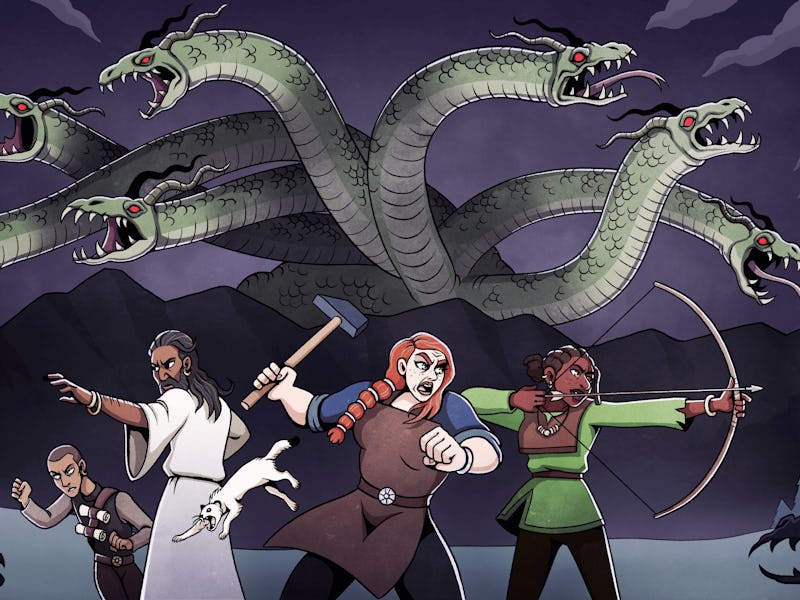Pyrene Combines Two Popular Genres to Build Something Totally Unique
The whole world’s in your hand.

Roguelike deckbuilders have exploded in popularity since the success of Slay the Spire. Plenty of games in the subgenre put enough of a spin on its basic tenets to stand out, but their battle systems often feel nearly the same regardless. Then there’s Pyrene. Launching Sept. 13 on Steam, Pyrene pulls from deckbuilders and dungeon-crawlers alike to build something entirely fresh, and it’s worth seeing even if you’ve had your fill of other card games.
If you’re looking for a point of comparison for Pyrene, Square Enix’s Voice of the Cards is a much closer fit than Slay the Spire. As is the case in that Yoko Taro-directed game, cards in Pyrene don’t just represent your attacks — they represent the entire world. Every map in Pyrene is made up of cards, each representing a different square on the ground that your character (also a card) moves across. But it takes that central concept even further than Voice of the Cards, bringing the same movement system into its challenging tactical battles.
Pyrene is a refreshing, captivating mix of roguelike deckbuilder and dungeon-crawler.
At the start of Pyrene, your village has been destroyed by the sudden emergence of hordes of monsters. You set off to track down your now scattered neighbors and put an end to the monstrous blight with little more than a bow and some healing herbs in hand.
Each stage in Pyrene is essentially a dungeon, with every room either featuring an upgrade to collect (or purchase) or a battle. On most stages, the card-based movement system doesn’t affect much, but its rules define combat stages. When you begin a fight, every space on the board is a card, which can be either an enemy or an item. Your hand of cards will always make up a portion of the items available, with the rest chosen randomly based on which stage you’re in. Moving over an item will use it if it’s equipment or pick it up if it’s a resource like gold or spirit, which powers your special abilities. Bumping into an enemy will cause both you and your foe to do damage equal to your current health. The catch is that you can only move to a square with a card on it, and resetting the board to fill in empty spots with more cards costs provisions, or health once you’ve exhausted that extremely limited resource.
Each of Pyrene’s charcters brings wildly different mechanics to battle.
It’s a system that makes the game easy to play and understand at a glance, with immense depth afforded by its simple mechanics. Since you can’t retrace your steps without ending a turn — which also strengthens enemies — you need to plan your route carefully. If you’re not thinking ahead, it’s easy to get yourself stuck with nowhere left to move or leave a monster on the board that you can’t afford to let get any stronger.
Aside from clever movement, smart deckbuilding is also key to success in Pyrene. You can only bring a limited number of cards into any battle, regardless of the size of your deck, but choosing which to equip is only half the battle. More important is collecting them in the first place.
Like in so many other deckbuilders, Pyrene lets you collect relics for passive effects and add more cards to select in battle. But another key part of Pyrene that sets it apart from similar games is just how weird those builds can get. Some relics may just empower certain cards or give you defensive bonuses, but they open the door for more interesting strategies as well. One of my favorite combos involves stacking relics and cards that grant both your character and all enemies a buff that allows them to dodge a single attack, then combining it with another relic that turns every enemy dodge buff into poison instead. That little trick enables my character to become invincible for a turn while whittling down enemies’ health just by moving.
Each level has its own twists to contend with.
As you progress through Pyrene, you also gather your lost neighbors and rebuild your town. Each run into the wilderness lets you bring back wood to build structures for additional bonuses, but only by defeating bosses will you find fellow villagers. Rescue one, and they’ll turn into a playable character you can bring on future runs, which can vastly change the game. The very first character you recruit goes into battle with his loyal pet ermine, letting you swap control between the two at any time. The next has low health but high armor, which she can spend to do damage to enemies while removing its protection.
Pyrene has plenty of competition from other deckbuilders, but it sets itself apart in so many ways that it’s still easy to recommend. Its deep strategy is incredibly satisfying, with short runs that make it tempting to go back for another attempt time after time after time. And whenever you’ve gotten good enough to conquer the next level, you’re rewarded with a new character to give you a whole new set of mechanics to master. Pyrene will naturally appeal to players who are looking for their next deckbuilder, but it brings so many original ideas to the table, it’s worth checking out even if you think another card game isn’t for you.